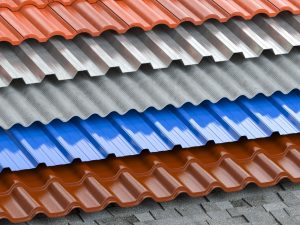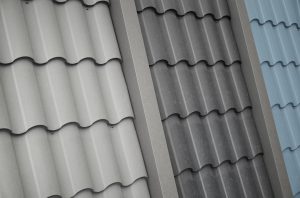Once relegated to commercial or utility buildings, metal roofing has made real gains in popularity for North American residential buildings in recent years. By some estimates, the market for residential metal roofing has more than quadrupled over the past decade. This trend is expected to continue, with demand for metal roofing increasing as much as 2.7% per year through 2023. One of the biggest reasons for the shift toward metal roofing is the incredible durability it offers over asphalt shingles, which need to be replaced every 20-30 years. Many homeowners considering making the switch wonder about the pros and cons of metal roofs. This article explores not only what metal roofs are but also some of their most common benefits and drawbacks.
What Is a Metal Roof?
 Metal roofs consist of large, flat metal panels. Often, metal roofs are made of steel or aluminum, but copper and zinc are also popular options. They feature raised edges that run vertically where the seams overlap, with the fasteners protected from the elements by the “standing seams.” Prior to this trend in residential roofing, they were used almost exclusively for commercial and utility buildings. Many people are surprised to learn metal roofs have actually been around much longer than most realize. In fact, Thomas Jefferson, who was a very successful architect in addition to being a founding father, lauded the benefits of metal roofing. The iconic dome of the Monticello, Jefferson’s primary home, featured a tin shingle roof.
Metal roofs consist of large, flat metal panels. Often, metal roofs are made of steel or aluminum, but copper and zinc are also popular options. They feature raised edges that run vertically where the seams overlap, with the fasteners protected from the elements by the “standing seams.” Prior to this trend in residential roofing, they were used almost exclusively for commercial and utility buildings. Many people are surprised to learn metal roofs have actually been around much longer than most realize. In fact, Thomas Jefferson, who was a very successful architect in addition to being a founding father, lauded the benefits of metal roofing. The iconic dome of the Monticello, Jefferson’s primary home, featured a tin shingle roof.
The Pros of Installing a Metal Roof
With its many benefits, it is not difficult to understand the growing popularity of metal roofs for residential buildings. Here are some of the most common pros of installing a metal roof.
Longevity & Durability
 Hands down, this is the most commonly cited reason homeowners make the switch to a metal roof. While asphalt shingles are designed to last 20-30 years, metal roofs are estimated to last 40 to 70 years. Some metal roofs have even lasted well more than 100 years. With an asphalt roof, a homeowner anticipates replacing it at least once, maybe twice more. When a homeowner opts for a metal roof, they are effectively installing a roof that will last a lifetime.
Hands down, this is the most commonly cited reason homeowners make the switch to a metal roof. While asphalt shingles are designed to last 20-30 years, metal roofs are estimated to last 40 to 70 years. Some metal roofs have even lasted well more than 100 years. With an asphalt roof, a homeowner anticipates replacing it at least once, maybe twice more. When a homeowner opts for a metal roof, they are effectively installing a roof that will last a lifetime.
In addition to their longevity, metal roofs are incredibly durable, capable of standing up to the elements in ways other roofing materials just can’t. In fact, when properly installed, metal roofs can sustain wind gusts of up to 140 mph, will not corrode or crack, and are largely impact resistant (depending on the metal you choose). They don’t require costly maintenance and are not subjected to algae or mold growth. They last, while still gleaming like they did when they were first installed.
Energy Efficiency
 Homeowners are often surprised to learn that metal roofs are also an energy efficient option. While asphalt shingles absorb radiant heat, metal shingles act as a radiant heat block, causing heat from the sun or from inside the home to reflect back. This means that in the summer, a metal roof reduces the amount of heat entering the upper level of the home (reducing AC costs), and in the winter, a metal roof is limiting how much heat escapes the home (reducing heating costs). Depending on the color choice, a metal roof can reflect back as much as 83% of the sun’s radiant heat, making it a cool roofing option.
Homeowners are often surprised to learn that metal roofs are also an energy efficient option. While asphalt shingles absorb radiant heat, metal shingles act as a radiant heat block, causing heat from the sun or from inside the home to reflect back. This means that in the summer, a metal roof reduces the amount of heat entering the upper level of the home (reducing AC costs), and in the winter, a metal roof is limiting how much heat escapes the home (reducing heating costs). Depending on the color choice, a metal roof can reflect back as much as 83% of the sun’s radiant heat, making it a cool roofing option.
Fireproof
For homeowners in dry regions, the flammability of the roofing material is a significant consideration. In fact, in certain parts of California, where wildfires are a significant risk, certain roofing options, like wood shingles, are not permitted due to their tendency to catch fire. Even in the Midwest, a fireproof roof offers peace of mind that it will not spark during a thunderstorm and catch fire.
While we’re on the subject of thunderstorms, it’s worth nothing that metal roofs do not increase the likelihood of the building being struck by lightning. In fact, a metal roof may actually decrease the damage your home sustains if it does get struck by lightning during a storm. As a highly conductive material, metal gives the energy produced in a lightning strike a low-resistance path to the ground. In an asphalt roof, the shingles and wood decking absorb this energy, often converting it to heat which may spark into a flame.
Environmentally Friendly
One significant pro of installing a metal roof is the positive impact your roofing choice can have for the environment. Made from 25-95% recycled materials, metal roofs are 100% recyclable at the end of their life. Asphalt shingles, on the other hand, contain polycyclic aromatic hydrocarbons (PAHs), which have been shown to be carcinogenic. Recycling asphalt shingles can be difficult, particularly for those containing asbestos, which is why they typically end up in landfills. More than 20 billion pounds of asphalt shingles are added to landfills every year.
The Cons of Metal Roofing
Though they have many advantages, there are some drawbacks to metal roofing that homeowners need to consider as they weigh their roofing options.
Cost
The cost of metal roofing is often cited as the most significant reason homeowners hesitate to make the switch. A metal roof may cost two to three times as much as an asphalt roof. However, when you factor in how long the roof will last and its limited need for maintenance, the lifetime cost of a metal roof is actually less than that of a traditional asphalt roof.
Noise
One of the first questions we get from homeowners considering a metal roof is how loud it will be during a rain or hailstorm. The truth is, metal roofs are louder than other roofing options. There’s a reason a lot of musical instruments are made of metal. They’re great carriers of sound. But, just like a musical instrument that’s been muted, proper insulation of metal roofs can dampen this noise considerably.
Limited Aesthetic Options
While their appearance will not diminish over time, metal roofs have limited aesthetic options compared to the seemingly infinite options that asphalt shingles offer. Most metal roofs are made with 2- to 3-foot-wide panels, joined together with raised seams. In response to the growing popularity of metal roofs for residential buildings, some manufactures are now offering metal shingles that more closely mimic the aesthetic of asphalt shingles. However, these are significantly more expensive. Matching the roof’s color may also be difficult if, years after installation, you need to either complete repairs or opt to add an extension on to your home.
Expansion & Contraction
If not properly installed, these panels may eventually loosen as they cycle through the hot and cold seasons. Proper, professional installation is a must for metal roofs. It’s important to not only work with a professional roofing company, but also to find one who is trained to work with the specific roofing systems you’re looking to have installed. Product warranties often hinge on proper, professional installation by qualified contractors.
Trust Aapex Construction & Restoration to Put a Roof Over Your Head!
Aapex Construction & Restoration is specifically trained and instructed by our roofing vendors on the proper installation of their products according to very strict specifications. We meet all requirements to be able to provide our clients with the registered product warranty in addition to our 10 year or Lifetime warranty of workmanship. We achieve a higher standard of service and are considered preferred contractors with all of our suppliers. Contact us today to schedule a consultation.
Related Articles
Built to Last: The Life Expectancy of 5 Popular Roofing Materials
Cool Roofs: What They Are & Why They Are Trending
Hail Damage – What You Need to Know

